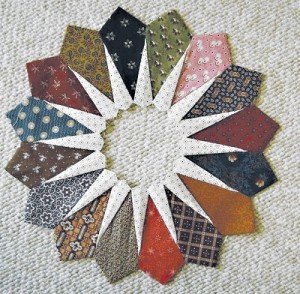Cherished for their craftsmanship, and elevated from a mere bed covering to one of the purest forms of folk art, quilts reflect the true spirit of the women of America.
Look at a collection of quilts from any seamstress and you will find identifying traits that connect them to their maker. The fabrics of choice will speak to the modest means or affluence of the home from which they came. The number of stitches per inch (six on the low side to twelve and even fifteen from the masters) will attest to the skills and patience. But, perhaps, the most telling trait may be the patterns the creator chose, for herein lies witness to the personality of the maker and the things they held most dear.
Sustained through life’s trials by daily devotions and Bible reading, the pioneer women of the early 1800s created a number of Biblical quilt patterns. Jacob’s Ladder, Job’s Tears, Garden of Eden, and Children of Israel are just of few of the many tributes the women of the 19th Century created as a statement of their faith.
The compassion and courage of the women of the mid-1800s can be found in a number of patterns that were used to assist the migration of the slaves from the South to the North. The popular Flying Geese pattern pointed the way to safe harbors, food and water. Drunkards Path was used as a warning that slave hunters were in the area and a zig-zag route was the safest way to proceed and the Rose Wreath was hung on the clothes line to show respect for a slave that had died on his journey to freedom.
The Biscuit pattern, also known as a “puff quilt,” was one of the most popular quilts of the American Victorian era, 1876-1914. They were most commonly made of satin and velvet and were considered a sign of social position and affluence. Due to the fabrics used they were not very practical and were often used more as bed cover or decorative piece. For this reason many of these beautiful creations have survived in good condition.
Although it first appeared in the late 1890s, the Double Wedding Ring pattern saw a resurgence in popularity when it was published in Cappers Weekly in 1928. From the late 1920s through the years of the Great Depression many early quilting patterns, including Grandma’s Flower Garden, Sunbonnet Sue, and Dresden Plate were revived in popular publications of the day. Characterized by their use of feed sack fabrics and sewing scraps, these bright colored quilts bear witness to the optimistic character of the American housewife during one of the darkest times in our nation’s history.
Politics and controversy have found their way into the world of quilting. Long before women could vote, they could express their political beliefs through quilting. One-of-a-kind patterns have been designed to protest wars, support political candidates, and to honor the achievements of those men and women who have served their country in the military. While this form of quilting became popular during the Civil War years, the tradition was revived in the 1980s as quilts surfaced both in favor and in opposition of the Gulf War.
Through good times and bad the women of America have created the antique quilts of today. If you have one cherish it, for every stitches bears witness to the strength and the spirit of its creator. Until next time . . . . Linda
Linda Kennett is a professional liquidation consultant specializing in down-sizing for seniors and the liquidation of estates and may be reached at lkennett@indy.rr.com or 317-258-7835



